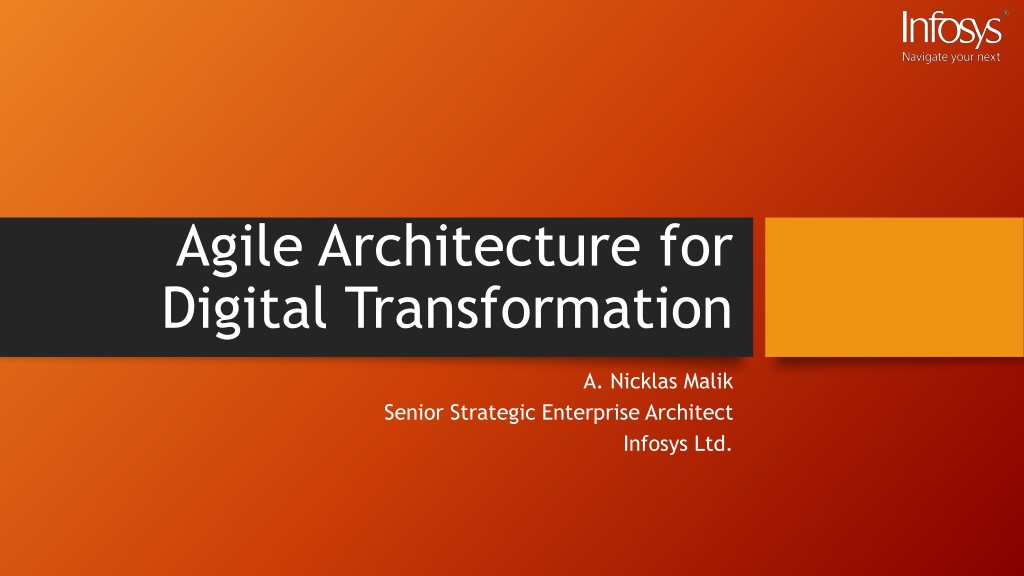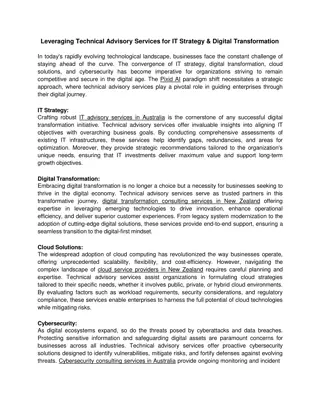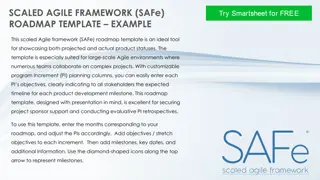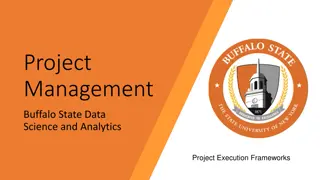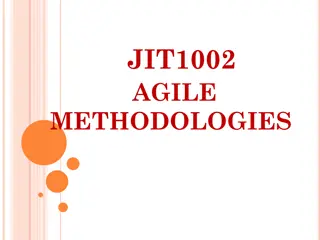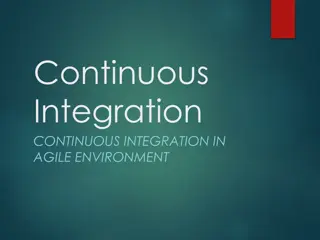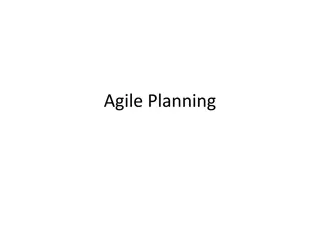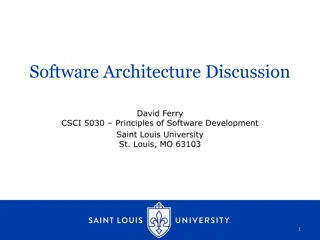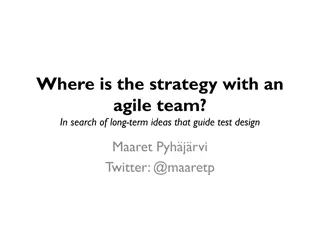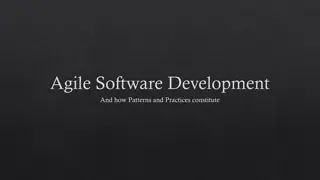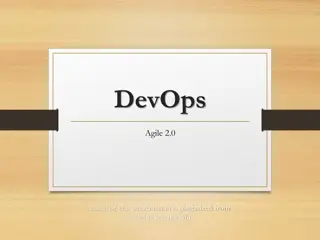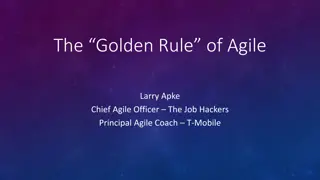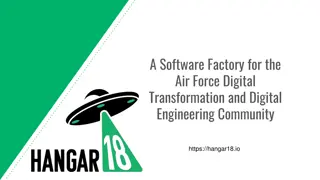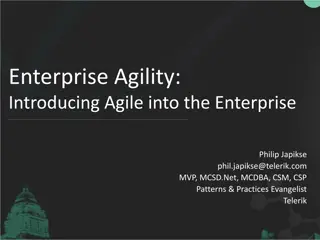Understanding Digital Transformation and Agile Architecture
Digital Transformation involves reorienting traditional business models to embrace new technologies and meet customer expectations. It is a strategic effort crucial for organizations aiming to stay competitive in the digital era. Agile Architecture complements this transformation by integrating agility into the architectural process, ensuring alignment with evolving business needs. The interaction between Agile Architecture and Digital Transformation is essential for organizations seeking to thrive in today's dynamic digital landscape.
Uploaded on Nov 19, 2024 | 0 Views
Download Presentation

Please find below an Image/Link to download the presentation.
The content on the website is provided AS IS for your information and personal use only. It may not be sold, licensed, or shared on other websites without obtaining consent from the author. Download presentation by click this link. If you encounter any issues during the download, it is possible that the publisher has removed the file from their server.
E N D
Presentation Transcript
Agile Architecture for Digital Transformation A. Nicklas Malik Senior Strategic Enterprise Architect Infosys Ltd.
What exactly is Digital Transformation Digital Transformation is a type of strategic effort that promises to reorient a traditional organization s business model to take advantage of new technologies, adopt modern mobile and social experiences, appeal to customers who are increasingly connected and meet their expectations for service, ease, and seamless use of digital technologies. Customer Experience First Data Intensive Intelligence at the Edge Mobile Ready Social Omnichannel
Digital Transformation is important The global digital transformation market was valued at USD 998.99 billion in 2020 and is expected to reach a value of USD 2744.68 billion by 2026. Results Provided By Enabled By Artificial Intelligence Disruptive Business Models Digital Experience Platform Big Data Analytics Seamless Customer Experiences Microservice Flexibility Internet of Things Elastic Cloud Scalability Greater Customer Reach Agile Software Practices 5G Internet Connectivity
Sometimes, Enterprise Architecture looks like this Traditional Enterprise Architecture is unprepared for Digital Transformation Photo credit: Associated Press
Agile Transformed Software, Not Architecture Agile Manifesto What happened to Software Development Remove team boundaries (dev, test, operations), increased automation (CI/CD), taught devs how to test and deploy What happened to Architecture Nothing Architecture is still process and tool driven. Separate teams, unique models that no one reads Individuals and interactions over processes and tools Working software over comprehensive documentation Customer collaboration over contract negotiation Responding to change over following a plan Small deliverable stories describe the results not the design. Unit Tests prove MVP features. YAGNI cut gold plating. Nothing Architects produce detailed diagrams that devs don t use. future proof gold-plated designs Frequent presentations to customers to get feedback, involvement of business in creating stories Nothing Frameworks still refer to formal Architecture Requests Fixed duration cycles with prioritized features at the start of each one created the concept of Minimum Viable Product Nothing Architects are still expected to deliver interim and future state models YEARS in advance
Forcing EA through the Agile Transformation Agile Manifesto Individuals and interactions over processes and tools After Transitioning to Agile Architecture Architects take a stake in the success of the solution. They are full time members of an agile release train. Standards accelerate the team and reviews are done on demand. Architecture Review Boards exist for visibility with a very limited role in governance. Architects learn performance testing, security probing, and operations measurement. Architects rely on canonical transactions, events, services, and platforms to provide future flexibility, while focusing on delivering a small number of useful models for the development team to use. Architecture is used in prioritization and pruning and is demonstrated during sprint demonstrations to both the devs and business stakeholders. Architects are proactive, working with business stakeholders to create an architectural concept prior to initiating an effort, and demonstrating the model changes at each sprint demo. Working software over comprehensive documentation Customer collaboration over contract negotiation Responding to change over following a plan Future models are used to advise the acquisition of software products and platforms. Design is guided by principles, not static models. Models are updated frequently using integrated architecture tools.
The Value Proposition of Agile Architecture We provide the same value, but in different ways: We reduce complexity by personally working with teams to use standard patterns, systems, models, and information. We avoid mistakes by leveraging the shared knowledge of the entire team, not just the ivory tower . We adopt innovative ideas by experimenting and driving proofs of concept through the Agile Release Trains themselves We improve alignment by creating the architectural vision and owning a portion of the capacity in each program increment for architecturally relevant stories
Reducing the Number of Architecture Roles Scaled Agile Framework (SAFe) defines four roles that interact with architecture. That s inherited from waterfall. Let s reduce that number. SAFe Defined Roles Agile Architecture Roles Ecosystem design Integrated Solution within Evolving Ecosystem Bounded Solution within Evolving Platform Module Level Design in Code Enterprise Architect Solution Architect* System Architect* Lead Engineer Agile Enterprise Architect Solution design System Architect Technology design Code-level design Lead Engineer *SAFe does not consistently define roles. Some pages describe the roles differently. Design responsibility flips. Instead of an architect being responsible for designing a system, an architect designs a solution within an ecosystem. This is far more aligned with an emerging ecosystem of (micro) services.
Capability Improvement and Alignment Traditional Enterprise Architecture teams break out Business Architecture roles to define a capability model, map strategy to capabilities, measure their maturity, and produce insights and recommendations for investment. The Scaled Agile Framework errantly ignores Business Architecture. Companies employing Agile Architecture remove the role distinction. An Agile Architect must be able to perform as a Business Architect in addition to the more technical aspects of developing a solution within an ecosystem. This reduces the handoff costs and fuels innovation. An IT architect who cannot perform in a business architecture role should be offered training and mentoring.
The Innovation Side of Architecture Agile Architects invest in learning innovative technologies, building skills in innovative uses of platforms, and evaluate the ability of new products to improve digital business models. Innovations are brainstormed during business discussions prior to creating the architectural vision. The architectural vision is used to create initial epics for various teams in an Agile Release Train. Agile Architects are not required to master coding, deployment, or operational details of every innovative system. But they MUST learn the technology, understand how it works, and design for its constraints.
Confrontational vs. Collaborative Governance Traditional EA Governance is confrontational. It sets a barrier for teams to cross, where they must prove themselves to align to arbitrary standards. Unhealthy power dynamics and passive-aggressive behaviors often result. No good deed goes unpunished. Agile EA Governance is collaborative. It s the practice of creating discussing and reviewing all architecture as it evolves in a cross functional team, as it relates to deliverable systems. Architecture Review Board Agile EA Governance is flexible, adaptive, and driven by data instead of by ego.
The Capacity and Scope of Change Traditional Enterprise Architecture is rarely helpful to Digital Transformation. It can be actively harmful. 1. Move to collaborative governance and end the Architecture Review Board 2. Adopt Minimum Viable Architecture modeling in the Agile Release Trains You do not have to transform Enterprise Architecture prior to starting your Digital Transformation program, but you are not better off to wait. 3. Add investments in innovation, evaluation of new ideas, and presentation to business stakeholders. Don t change everything at once. Make changes first to the reduce the workload on EA. Add capabilities from there. 4. Grow to include Business Architecture and Capability alignment
Overcoming Criticisms of Agile Architecture Assert: there are two types of architecture: Emergent and Intentional. Intentional Architecture is not Agile and Emergent is simply chaos Architecture is the stuff that requires you to start over if it changes. Therefore, architecture cannot be emergent. This assumes no iterations and no collaboration. Agile EA is Emergent towards Intent, the best of both. Conflates the architect with the architecture. Emergent architecture is discovered, not planned. That doesn t mean it changed. You did. TOGAF says that you need an architecture review board to have effective governance. That advice is out of sync with the agile needs of Digital Transformation and demonstrates a real lack of trust of engineers.
Why make this move? Teams working on Digital Transformation have widely adopted Agile methods. Most Agile methods, including SAFe, do not define EA in an agile fashion, if at all. That leads to poor experiences with EA. Therefore, without Agile EA, Digital Transformation teams will frequently jettison Enterprise Architecture altogether. That increases the risk of failure, the likelihood of complexity, and the common case of blindness to the underlying problems that business architecture typically reveals. Agile EA aligns Enterprise Architecture with Digital Transformation
Your Presenter Avinash Nicklas Malik has a trouble-maker, systems breaker, and risk taker in the realm of Enterprise Architecture for the past 15 years. Former CIO, Servant Leader, and all-around force of nature, Nick will drive you to success in EA and show you the sights along the way. Email: Avinash.Malik@infosys.com Blog: http://VanguardEA.com LinkedIn: https://linkedin.com/in/nickmalik Tiktok: https://www.tiktok.com/@Nick_EnterpriseArch
